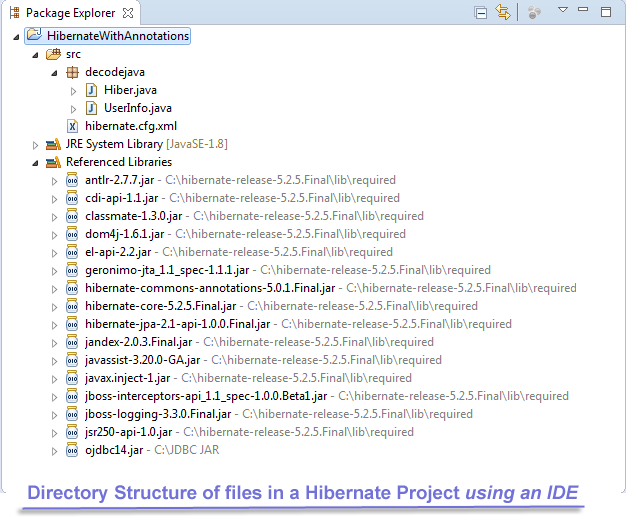Advertisement
@Entity (name = "USER_ADDRESS")
class UserAddress@Entity
@Table (name = "User_Info")
class UserInfo@Id
@Column (name = "Roll_Number")
private int rollNumber;Advertisement
@Id
@Column (name = "Roll_Number")
@GeneratedValue
private int rollNumber;@Column (name = "First_Name")
private String FirstName;
@Temporal(TemporalType.DATE)
private Date createdOn;
@Transient (name = "Comment")
private String comment; package decodejava;
import java.util.Date;
import javax.persistence.Column;
import javax.persistence.Entity;
import javax.persistence.Id;
import javax.persistence.Table;
import javax.persistence.Temporal;
import javax.persistence.TemporalType;
import javax.persistence.Transient;
@Entity
@Table (name ="USER_INFO")
public class UserInfo
{
@Id
@Column (name = "ID")
@GeneratedValue
private int id;
@Column (name = "First_Name")
private String firstName;
@Column (name = "Last_Name")
private String lastName;
@Temporal(DATE)
private Date databaseCreatedOn;
@Transient
private String comment;
public String getComment()
{
return comment;
}
public void setComment(String comment)
{
this.comment = comment;
}
public int getId()
{
return id;
}
public Date getDatabaseCreatedOn()
{
return databaseCreatedOn;
}
public void setDatabaseCreatedOn(Date databaseCreatedOn)
{
this.databaseCreatedOn = databaseCreatedOn;
}
public void setId(int id)
{
this.id = id;
}
public String getFirstName()
{
return firstName;
}
public void setFirstName(String firstName)
{
this.firstName = firstName;
}
public String getLastName()
{
return lastName;
}
public void setLastName(String lastName)
{
this.lastName = lastName;
}
}package decodejava;
import java.util.Date;
import org.hibernate.Session;
import org.hibernate.SessionFactory;
import org.hibernate.cfg.Configuration;
public class Hiber
{
public static void main(String[] args)
{
SessionFactory sf= new Configuration().configure().buildSessionFactory();
Session session = sf.openSession();
//Creating the first object
UserInfo ob1 = new UserInfo();
ob1.setFirstName("Paul");
ob1.setLastName("Walker");
ob1.setDatabaseCreatedOn(new Date());
ob1.setComment("One of the best movies - Fast and Furious");
//Creating the second object
UserInfo ob2 = new UserInfo();
ob2.setFirstName("Leonardo");
ob2.setLastName("Dicaprio");
ob2.setDatabaseCreatedOn(new Date());
ob2.setComment("One of the best movies - Titanic");
//Creating the third object
UserInfo ob3 = new UserInfo();
ob3.setFirstName("Johnny");
ob3.setLastName("Depp");
ob3.setDatabaseCreatedOn(new Date());
ob3.setComment("One of the best movies - What's Eating Gilbert's Grapes");
//Saving the objects
session.beginTransaction();
session.save(ob1); //Saving the first object
session.save(ob2); //Saving the second object
session.save(ob3); //Saving the third object
session.getTransaction().commit();
session.close();
//Retrieve and displaying the user details.
session = sf.openSession();
session.beginTransaction();
ob1 = (UserInfo)session.get(UserInfo.class,1);
ob2 = (UserInfo)session.get(UserInfo.class,2);
ob3 = (UserInfo)session.get(UserInfo.class,3);
System.out.println("Retrieving the saved objects");
//Retrieving details of the first user.
System.out.println("First User");
System.out.println("Id : " + ob1.getId());
System.out.println("First Name : " + ob1.getFirstName());
System.out.println("Last Name : " +ob1.getLastName());
System.out.println("Datebase created : " + ob1.getDatabaseCreatedOn());
//Retrieving details of the second user.
System.out.println("Second User");
System.out.println("Id : " + ob2.getId());
System.out.println("First Name : " + ob2.getFirstName());
System.out.println("Last Name : " +ob2.getLastName());
System.out.println("Datebase created : " + ob2.getDatabaseCreatedOn());
//Retrieving details of the third user.
System.out.println("Third User");
System.out.println("Id : " + ob3.getId());
System.out.println("First Name : " + ob3.getFirstName());
System.out.println("Last Name : " +ob3.getLastName());
System.out.println("Datebase created : " + ob3.getDatabaseCreatedOn());
session.getTransaction().commit();
//closing the session
session.close();
}
}
<?xml version="1.0" encoding="utf-8"?>
<!DOCTYPE hibernate-configuration PUBLIC
"-//Hibernate/Hibernate Configuration DTD 3.0//EN"
"http://www.hibernate.org/dtd/hibernate-configuration-3.0.dtd">
<hibernate-configuration>
<session-factory>
<!-- Database connection settings -->
<property name="connection.driver_class">oracle.jdbc.driver.OracleDriver</property>
<property name="connection.url">jdbc:oracle:thin:@localhost:1521:XE</property>
<property name="connection.username">system</property>
<property name="connection.password">promila21</property>
<!-- JDBC connection pool (use the built-in) -->
<property name="connection.pool_size">1</property>
<!-- SQL dialect -->
<property name="dialect">org.hibernate.dialect.Oracle10gDialect</property>
<!-- Disable the second-level cache -->
<property name="cache.provider_class">org.hibernate.cache.internal.NoCacheProvider</property>
<!-- Echo all executed SQL to stdout -->
<property name="show_sql">true</property>
<!-- Drop and re-create the database schema on startup -->
<property name="hbm2ddl.auto">create</property>
<!-- Names the mapping entity class -->
<mapping class ="decodejava.UserInfo"/>
</session-factory>
</hibernate-configuration>
Hibernate: create sequence hibernate_sequence start with 1 increment by 1
Hibernate: create table USER_INFO (ID number(10,0) not null, databaseCreatedOn date, First_Name varchar2(255 char), Last_Name varchar2(255 char), primary key (ID))
Hibernate: select hibernate_sequence.nextval from dual
Hibernate: select hibernate_sequence.nextval from dual
Hibernate: select hibernate_sequence.nextval from dual
Hibernate: insert into USER_INFO (databaseCreatedOn, First_Name, Last_Name, ID) values (?, ?, ?, ?)
Hibernate: insert into USER_INFO (databaseCreatedOn, First_Name, Last_Name, ID) values (?, ?, ?, ?)
Hibernate: insert into USER_INFO (databaseCreatedOn, First_Name, Last_Name, ID) values (?, ?, ?, ?)
Hibernate: select userinfo0_.ID as ID1_0_0_, userinfo0_.databaseCreatedOn as databaseCreatedOn2_0_0_, userinfo0_.First_Name as First_Name3_0_0_, userinfo0_.Last_Name as Last_Name4_0_0_ from USER_INFO userinfo0_ where userinfo0_.ID=?
Hibernate: select userinfo0_.ID as ID1_0_0_, userinfo0_.databaseCreatedOn as databaseCreatedOn2_0_0_, userinfo0_.First_Name as First_Name3_0_0_, userinfo0_.Last_Name as Last_Name4_0_0_ from USER_INFO userinfo0_ where userinfo0_.ID=?
Hibernate: select userinfo0_.ID as ID1_0_0_, userinfo0_.databaseCreatedOn as databaseCreatedOn2_0_0_, userinfo0_.First_Name as First_Name3_0_0_, userinfo0_.Last_Name as Last_Name4_0_0_ from USER_INFO userinfo0_ where userinfo0_.ID=?
Retrieving the saved objects
First User
Id : 1
First Name : Paul
Last Name : Walker
Datebase created : 2018-05-18
Second User
Id : 2
First Name : Leonardo
Last Name : Dicaprio
Datebase created : 2018-05-18
Third User
Id : 3
First Name : Johnny
Last Name : Depp
Datebase created : 2018-05-18
Advertisement
Advertisement
Please check our latest addition
C#, PYTHON and DJANGO
Advertisement